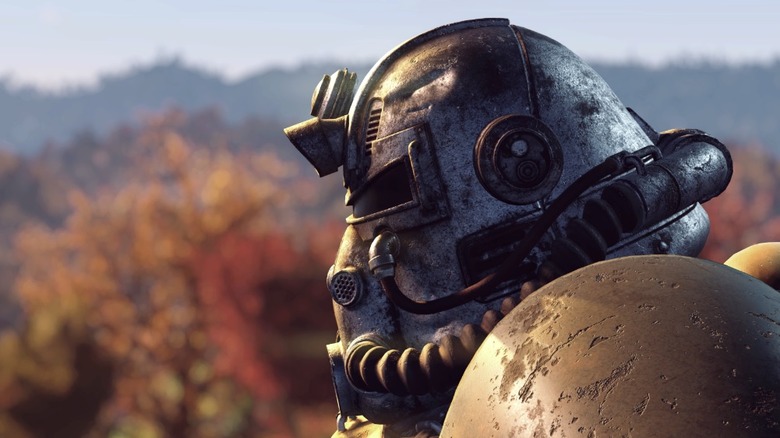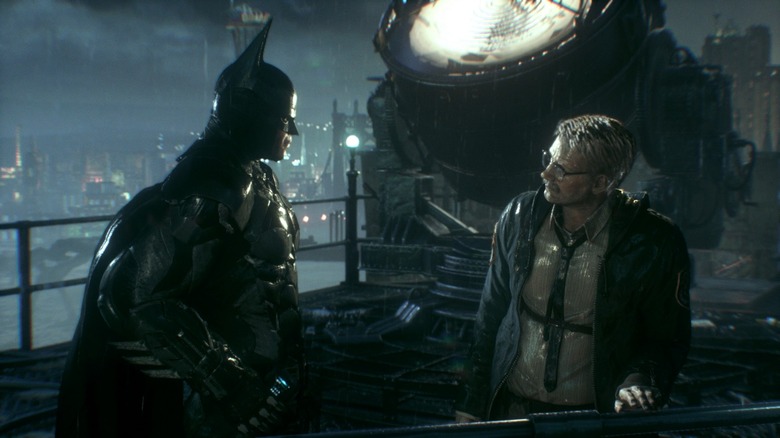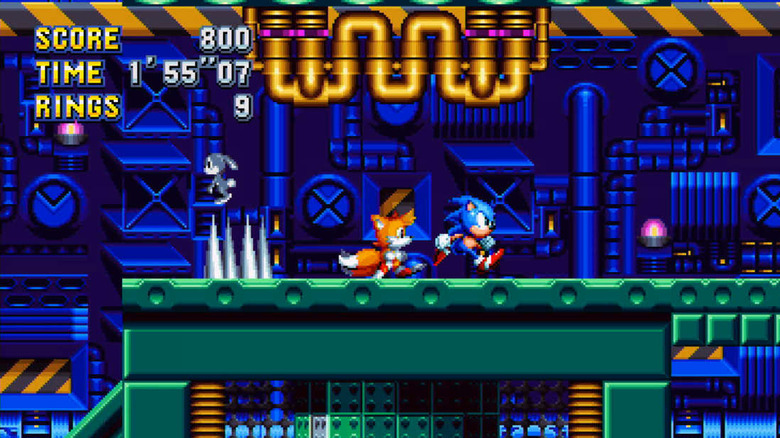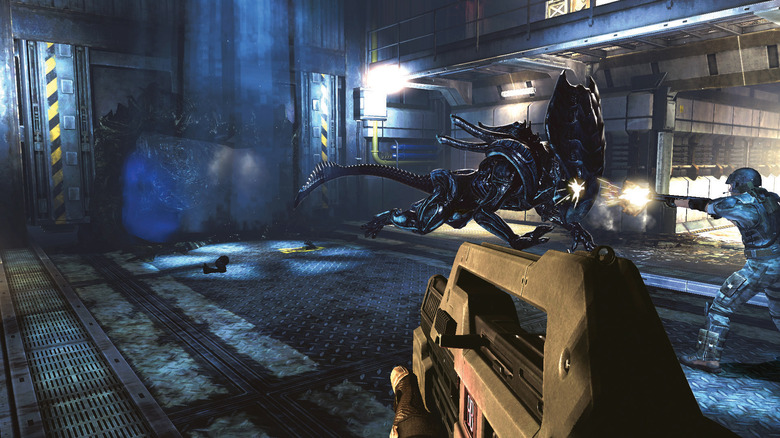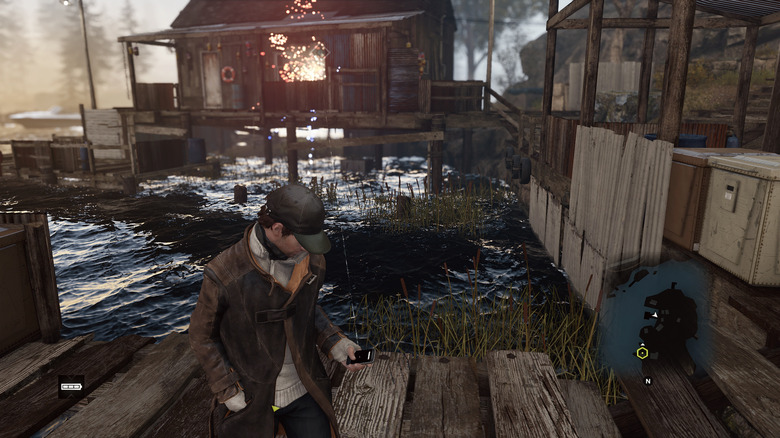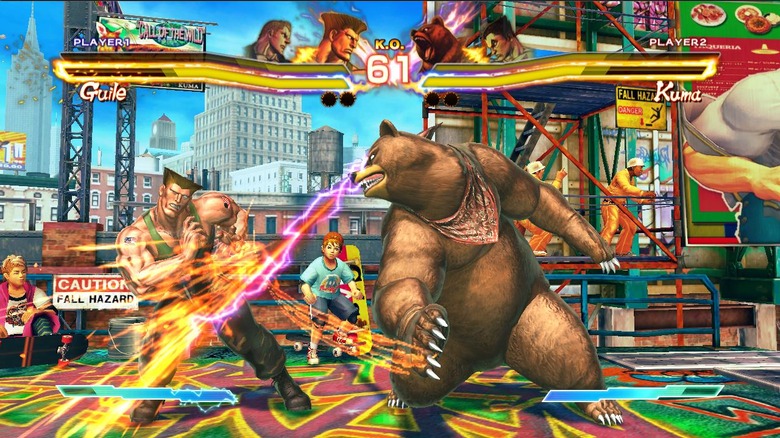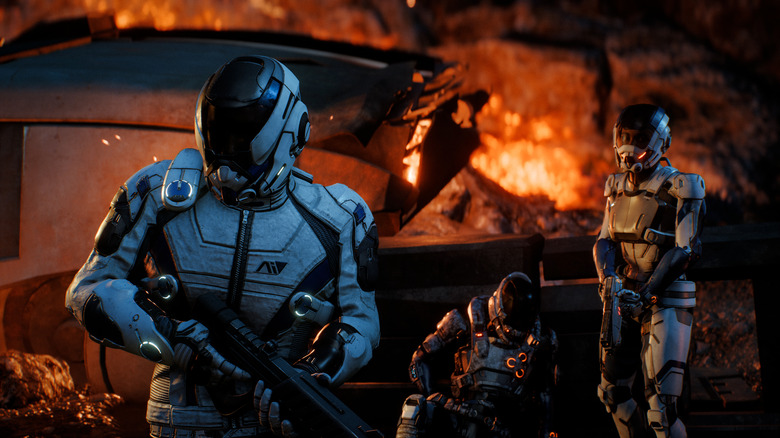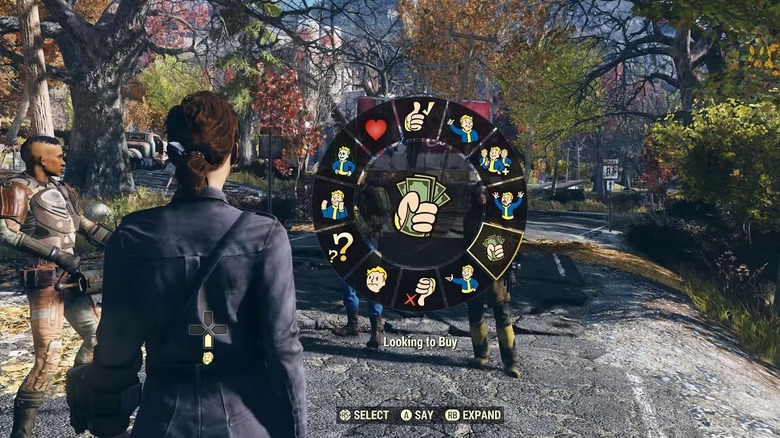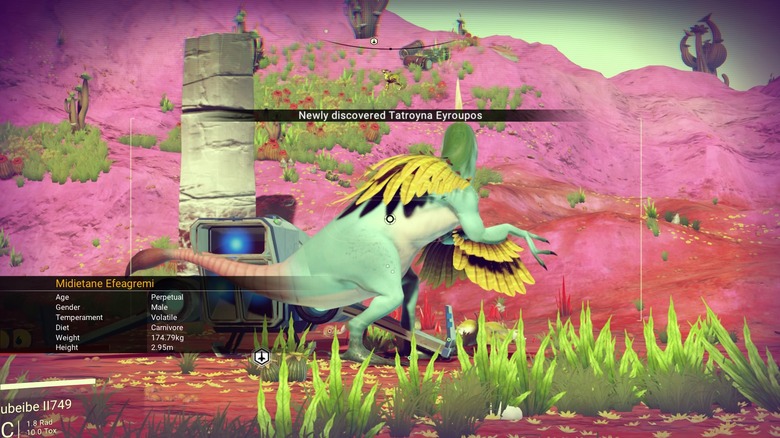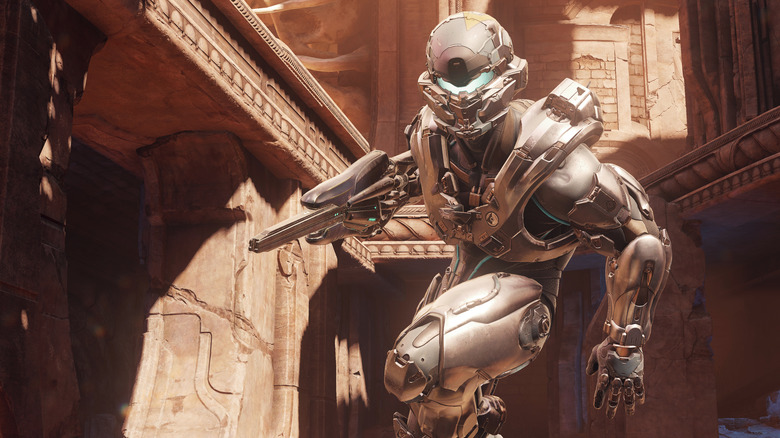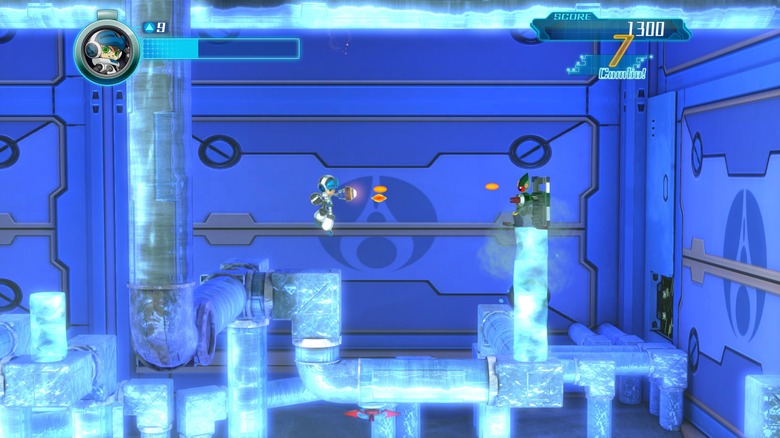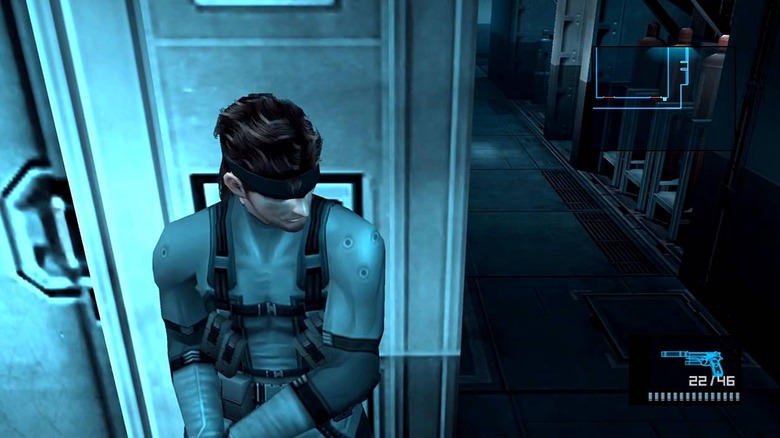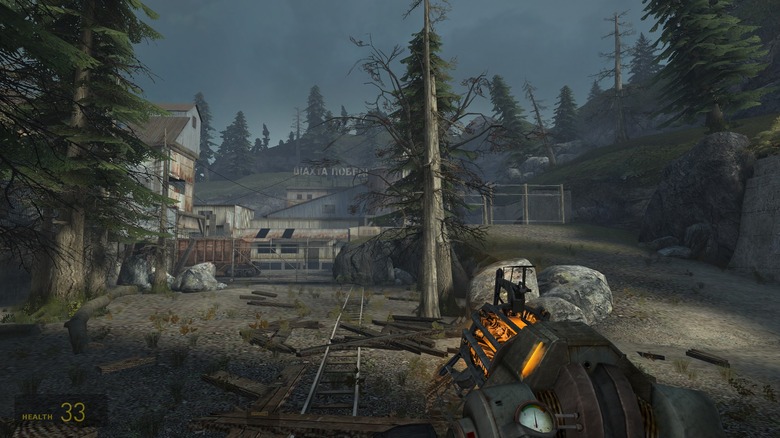Games That Pulled A Bait And Switch On Fans
The video game industry is still essentially the Wild West of the entertainment world, given how new it is and how few regulations have been put in place to prevent game companies from abusing consumers. That's why we've rounded up these games, all of which are notorious for having bait-and-switched fans. These corporate betrayals range from the mundane to the malicious, including misleading marketing, shady product delays, and a whole host of other sneaky tactics companies have employed in order to pull one over on their paying customers.
In case you needed a refresher on the seediness of the industry or want to learn why you should always stay frosty when buying games, the titles on this list are great examples of why it pays to be a smart, cautious consumer. Because, while some major game companies like CD Projekt Red and Nintendo are careful to only release products that live up to their internal quality standards, other publishers and studios whose games have landed on this list don't care quite as much. Read on to receive a crash course in how games, both old and new, have bait-and-switched fans over the years.
Arkham Knight's Joker port
Though Batman: Arkham Knight was a divisive game in terms of its design and story, those are both subjective topics, and the only topics console players could quarrel about the quality of. PC players, on the other hand, got to band together to say that the their port of Arkham Knight was objectively trash, for reasons entirely unrelated to the game itself — chiefly because most players couldn't even play the game. That's right: Warner Bros. released a PC port so bad that, for a vast amount of players, the game couldn't even run properly. Players experienced an absurd number of issues, ranging from constant crashes to unacceptable framerates on expensive graphics cards.
The port was a train-wreck, so much so that WB eventually took the drastic measure of removing the game from Steam altogether while offering unlimited, no-questions-asked refunds for anyone who bought the game before it was delisted. Eventually the game came back to Steam, many, many months after it had been extensively reworked, but even that release wasn't perfect.
This massive scandal becomes infinitely more disgusting when you consider that WB hid all flaws in preview footage, refused to delay the PC port when these issues became apparent internally, and willfully failed to prevent consumers from blindly waltzing into a digital dumpster fire. WB lied to fans loudly and shamelessly, leading to one of the most disgraceful PC game launches in history.
Denuvo's gotta go, fast
For the longest time, any news regarding Sonic Mania was good news. But Sega found a way to muck it up with less than a week left until the game's release.
96 hours before release, Sega announced that Sonic Mania's PC port would be delayed by two weeks for "optimization." Sega pulled this little stunt four days before the game's launch! The company offered people who pre-ordered the game on PC a free copy of Sonic the Hedgehog (1991) as an apology, but the damage was already done. The game came out on consoles as scheduled, and Sonic fans on PC had to sit and pout while trying to avoid Mania spoilers online.
Then, when Mania finally arrived on PC two weeks late, it came with a new surprise attached: Denuvo, a controversial anti-piracy software that punishes paying consumers and is rumored to hamper computer performance. So not only did Sega delay Mania on launch week, but according to the evidence at hand, the company lied about why it did it and went on to insert a nasty piece of intrusive, unwanted software into the game. Keep in mind that pirates still cracked Mania days after launch, meaning illegal downloaders essentially got the best version of Mania, the one free of Denuvo, for zero dollars just a few days after paying customers suffered through the release delay. Not only was this whole situation embarrassing for Sega, but also insulting to the paying fans.
Gearbox's xenomorph fiasco
If you haven't heard of Sega's and Gearbox Software's infamous Aliens release, Aliens: Colonial Marines, let us get you up to speed. Aliens: Colonial Marines was announced in the late 2000s and info about the game was steadily fed to fans between 2011 and 2013. When the game finally came out in February of 2013, however, it bore little resemblance to any of its own promotional reels, trailers, and marketing footage. What was advertised as a tense, nail-biting FPS built to capture the atmosphere of the Aliens universe ended up being a mindless, underbaked shooter with shoddy graphics, numerous bugs, and a host of other issues that greatly hampered the experience.
Needless to say, the game's failure to resemble its marketing materials caused quite an uproar amongst consumers, who felt they'd been conned into paying for a game remarkably inferior to the one they'd been sold on. These fans were so angry that an actual lawsuit was filed against Gearbox and Sega, with infighting ensuing between the two companies regarding who was to blame for Aliens: Colonial Marines' failure.
Ubisoft's grand charade
If you compare Watch_Dogs' 2012 E3 footage to the final product we received years later, it's no understatement to say that this is arguably the biggest bait-and-switch in all of video gaming. It's incredible how vastly different the previews were from the retail release.
The previews sold this game as the next Crysis-level industry bar-setter in terms of visual fidelity and luster. The marketing footage reels featured shadow and lighting effects of a caliber gamers had never seen before, as well as impressive fog and wind technology, all of which took the game's already incredibly detailed environments to new heights. When the game released, however, the graphics looked two generations older than what had been shown off up to that point, and the disparity in graphics only made them look even worse by comparison. All of a sudden, the "next gen" of consoles (which, at the time, were the PS4 and Xbox One) were repping a game that looked like it was a PS3 launch title.
Graphics weren't the only casualty in Ubisoft's infamous bait-and-switch. Gameplay took a hit as well. The preview footage showed the world being more immersive and interactive than what we got, and the game's central hacking gimmick looked a heck of a lot more engaging in promotional clips than what it ended up being in the retail release. In the final product, the game's primary mechanic ended up being little more than a single button you could tap to distract, and occasionally eliminate, enemies. Lame.
DLC, squared
Downloadable content (DLC) practices in the gaming industry are almost always seedy, what with companies nickel-and-diming consumers in every way imaginable. Some companies offer season passes, which often double the price of the game on day one for DLC content you won't receive for months. Other publishers release paid DLC the day the game releases, meaning you won't get the full experience even if you pay the base retail price.
No matter how you slice these DLC practices, they're all built to feed the same corporate trait: greed. And Capcom got greedier than anyone imagined when they released Street Fighter X Tekken, a game where DLC characters were already on the game disc. This meant that full, playable characters were on the disc of the game you just bought, but you had to pay extra, on top of what you just spent, to gain access to them. Imagine if you spent a lot of money on a vault, and then found out you had to pay additional fees for the key to unlock it. That's what Capcom did. And they didn't even fess up to their crime until some hackers exposed them, at which point they gave a weak explanation that failed to wipe away the game's soiled reputation.
Frostbite Effect: Andromeda
Mass Effect: Andromeda was hyped by EA as the follow-up to the Mass Effect trilogy, the fourth act in a series that had, by and large, earned a lot of goodwill with gamers the world round. And Andromeda's marketing definitely succeeded in selling the game as a worthy torchbearer of the franchise's name. The game's trailers and previews painted Andromeda as a technological step forward thanks to the game's utilization of the Frostbite engine, and told us the game would explore imaginative galaxies unlike anything we'd ever seen before. We were told we would meet new species and go on exciting new journeys throughout space. Though a lot of this sounded like tired assortments of advertising buzzwords, the reality was that if any game had the talent and tools to make good on its lofty claims, it would be Mass Effect: Andromeda.
Then the game came out, and it was revealed that EA's marketing machine had hoodwinked Mass Effect fans. Andromeda was riddled with serious bugs and sloppy animations (especially with regards to characters' faces), failed to introduce any substantial, game-changing sci-fi elements to the established ME universe, didn't deliver a compelling narrative on par with previous entries in the series ... basically, Andromeda missed its mark on a lot of fronts — fronts that were carefully hidden from view right up until the game hit store shelves.
The fallout of Bethesda's bad intentions
Fallout 76 was supposed to be the franchise's glorious first dip into multiplayer. Fans were skeptical, but Bethesda assured everyone that it knew what it was doing. Todd Howard himself made it clear he and his developers were going to get it right, immediately before announcing the game's collector's edition. Even as Bethesda revealed the game would be dodging Steam, and even after the beta went disastrously, optimism was still present.
Then the game launched and everything fell apart. Dedicated fans who ordered the game's $200 collector's edition received a flimsy nylon bag instead of a sturdy, quality canvas bag, the latter being what was actually advertised. Bethesda then offered five dollars' worth of microtransactions to shut angry customers up, before finally offering replacement canvas bags to be delivered months later. Then Bethesda accidentally doxxed customers who contacted its support team. It also started arbitrarily banning people and patronizingly demanded essays of apology in order for affected users to be unbanned.
As for the game itself, the software buried beneath all this controversy, it was riddled with bugs, glitches, and network errors, was hollow and boring, and lacked the level of depth and detail that made Fallout interesting. And, since it wasn't released on Steam, refunds were nigh impossible. From the false advertising of the canvas bag to the undercooked game at the heart of the matter, as well as everything else in-between, Fallout 76 was Bethesda's biggest bait-and-switch yet.
No Man's Lie
No Man's Sky was the game where the development ethos, at least the one Hello Games sold to consumers, was that the sky was no longer the limit. This game was aiming to be an infinite galaxy of opportunities at your fingertips. So many claims from the devs and from pre-release footage made the game out to be something truly extraordinary. We were told there would be multiplayer, and diverse, intriguing factions of enemies and allies. We were told there would be deep, engaging lore. We were shown footage of a game where every planet was unique and beautiful, loaded with massive packs of indigenous animals interacting naturally with one another. We were sold a lifelike experience.
Then the game released.
No Man's Sky, in its launch state (not the improved state the devs managed to get the game to years later via patches and updates), was a grade-A con-job. Hello Games overpromised big time, and it showed. None of what we mentioned above ended up in the game at launch. In fact, most of the magic of the trailers and pre-release footage failed to make it into the retail release, which was comparatively desolate and uninspiring. The abundance of life and organic ecosystems we'd seen in the marketing for the game were nowhere to be found in the game itself. While we're sure Hello Games and Sony just wanted to get us as excited for No Man's Sky as they were, that doesn't excuse the deceptive advertising.
Microsoft's half-truths with Halo 5
Halo 5: Guardians was advertised as an epic clash of heroes between Spartan Locke and Master Chief. The game's marketing gave us a logline too tantalizing to ignore: Master Chief has gone rogue, and a brave Spartan, Jameson Locke, has been sent to bring him in. That setup raised so many intriguing questions: why would Chief go AWOL? Would Locke actually try to subdue the venerable Chief? What would that fight look like? All these questions swirled around Microsoft's advertising blitz for Halo 5: Guardians, and the carefully marketed mystery got the franchise's fan community super stoked.
Then the game came out, and the hunt for Chief took backseat to a less engaging, less savory plotline that took beloved characters in unfavorable directions. Furthermore, the big showdown between Locke and Chief ended up being relegated to a very, very underwhelming cutscene. In Microsoft's defense, the "rogue Spartan" angle was great bait, and it's understandable why they'd use something super juicy like that for marketing. On the other hand, this game's plot was no Captain America: Civil War, and it's disheartening MS chose to advertise it as such.
Not-So-Mighty No. 9
Mighty No. 9 was a troubled Kickstarter game lead by Keiji Inafune, a man who'd spent many years working on Mega Man games. Given Capcom's abandonment (at the time) of the Mega Man IP, Inafune saw an opportunity to bring that style of game back to life through his very own project. Thus, Mighty No. 9 was born, claiming to be a spiritual successor to Mega Man.
The game's Kickstarter project went smoothly, for a while. Communication and interactivity from the devs was good, fun stretch goals were announced, and everything was shaping up for Mighty No. 9 to be a Kickstarter success story.
Slowly but surely, however, things turned sour. Mighty No. 9's previews shifted art styles and the game, in a lot of people's' opinions, got uglier over time. Inafune's team started another Kickstarter project before the initial one had even wrapped. The game got hit with multiple delays while all this was happening. These things came together to warp the public's perception of Mighty No. 9, to the point where people were no longer excited, but worried and frustrated.
Thankfully, the game did eventually come out and most of the Kickstarter project's goals were realized, but the finished product achieved nowhere near the precision-platforming magic of the ye olde Mega Man games it was imitating. Though Mighty No. 9 wasn't a bad game, it never lived up to the hype it had so gladly generated in order to take fans' money.
Stealthy marketing for a stealthy game
Of all the bait-and-switches on this list, Metal Gear Solid 2's is one of the least harmful to consumers, as it doesn't involve shady DLC gimmicks, broken launches, or other such sinister practices. MGS2's big sin is that it marketed itself as a game where you play as Snake, when in actuality the bulk of the game puts you in control of Raiden.
While this may be seen as an egregious case of shady marketing to hardcore Snake fans, it didn't result in diminished quality of the final product, didn't ruin the game's narrative, and didn't cause any damage besides an artistic rift with certain players. In this sense, it's not that bad of a bait-and-switch. Heck, it was actually pretty cool for a lot of players, when they realized Hideo Kojima had managed to hide the bulk of the game from them in previews. That kind of crafty surprise is rare in gaming, and it was definitely an interesting move by Kojima and Konami.
It's like if a main series Sonic game had Shadow take over after the first hour, or if Mario got replaced by Luigi after the first world. It wouldn't change the gameplay all that much, but it'd definitely spice up the proceedings and provide a different perspective on events. And that was the neat thing about MGS2's Raiden: he added some worthwhile depth to the Metal Gear Solid universe and kept the Metal Gear formula fresh without changing its core.
Waiting half a lifetime for a sequel
Imagine if Marvel released Avengers: Infinity War, complete with its cliffhanger sequel-bait ending, but then decided it didn't want to release Avengers: Endgame afterward. If that sounds like an infuriating bait-and-switch on the part of the storytellers, now you know how every Half-Life fan has felt for over a decade.
It's been a long, long time since Half-Life 2: Episode 2 came out. The story ends with Gordon Freeman and Alyx Vance gearing up to take on the next leg of their episode-spanning journey, but just before the credits roll, Alyx's dad gets violently murdered. The last thing we see is Alyx holding her dead father in her hands.
And that's how the Half-Life story ends, as far as Valve is concerned. For years upon years, Gabe Newell and most people at Valve have coyly sidestepped or given non-answers to the majority of Half-Life-related questions flung their way, a PR strategy that doesn't look like it'll be changing anytime soon. So the next time Valve announces a second installment of something, be it an episodic release or a sequel to your favorite IP, realize that that's the bait, and the switch will be when it ends on a cliffhanger and Valve never releases a third game to tie up the loose ends. Please join us in a moment of silence for Half-Life 3.

